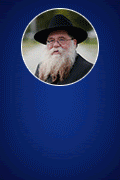New York, NY — The last few years in mainstream music have seen an explosion of bands influenced by Eastern European melodies and songs. From Jdub Record bands Balkan Beat Box and Golem to indie bands DeVotchKa and Beirut, everything from Roma lautari to klezmer music has been fair game. Recently, though, artists have been finding inspiration from a more mystical source - the niggunim of Chabad Lubavitch.
Chasidic Tunes Inspire Rockers
New York, NY — The last few years in mainstream music have seen an explosion of bands influenced by Eastern European melodies and songs. From Jdub Record bands Balkan Beat Box and Golem to indie bands DeVotchKa and Beirut, everything from Roma lautari to klezmer music has been fair game. Recently, though, artists have been finding inspiration from a more mystical source – the niggunim of Chabad Lubavitch.
Artists as diverse as jazz virtuoso Tim Sparks, rockers Soul Farm and roots reggae stars 12 Tribe Sound have found inspiration in the compositions of the Rebbes of Lubavitch.
An iconic image of Chasidic life is a Rebbe surrounded by his followers as they sing a niggun. A niggun, or a “humming tune,” is a spiritual song or devotional, frequently without words or lyrics. In some circumstances, the songs are joyous expressions of religious ecstasy. Other times they are slow dirges, designed to send shivers down the spine of the listener. In light of the niggun’s long history, going back to the Baal Shem Tov in the 17th century, its influence on modern musicians is unexpected and exciting.
“When a musician hears a melody that touches a deep chord, they can hear it and sense this is something really authentic,” Rabbi Asi Spiegel, Chabad representative from Eugene, Oregon, and a musician himself, explains. “Especially in our time where music has gone so commercial, people are looking for very deep musical outlets.”
Such was the case with the talented Tim Sparks, who released At the Rebbe’s Table in 2002 on Tzadik – John Zorn’s record label. The album marks an early beginning for this remarkable trend. Like the best niggunim, Spark’s album is a meditation on the experience of being a physical being in God’s spiritual world. Unlike niggunim, though, Spark’s marries the Chabad tradition to his extensive training as a jazz musician.
“My connection in the beginning was strictly through music, playing in bands for Bar Mitzvahs and weddings. Especially at weddings, I experienced the great feeling of joy, of simcha [happiness],” Sparks told Lubavitch.com. “It seemed to me that the more Orthodox families danced with the most intensity.”
Sparks is quick to point out that the seductive nature of niggunim is not merely contextual, but musical as well. “The niggunim have a quality, it’s unique. Especially something about that Freygish mode, the Phrygian scale with a raised 3rd. I like the songs with that sound. It is balanced between sadness and happiness. Bittersweet, soulful.”
Rabbi Joseph I. Schneersohn, the sixth Rebbe of Chabad-Lubavitch told about a meeting the first Rebbe of Lubavitch had with his teacher, the Maggid of Mezrich. In that meeting, his teacher told them that his mission would be to spread Chasidic teaching throughout the world, and to use niggunim to do so. Tim Sparks, who is not himself Jewish, says that he heard the call. “Working on this music sparked my interest in Judasim and prompted me to read the Tanakh. I continue to read the Tanakh and this has been a very liberating experience for myself, having been brought up in a Christian culture,” he says.
On the flipside of Sparks is Matisyahu, whose musical interests come from the Jamaican reggae culture, and who takes his lyrical cues from textual works of Chasidic writings. Matisyahu became acclaimed last year when his album Youth placed high on the Billboard music charts. On his hit single, King Without a Crown, Matisyahu sang: “And I sing to my G-d songs of love and healing / I Want Mashiach Now so it’s time we start revealing.” Placed within a rhyme scheme common to reggae music, but foreign to Chasidic culture, Matisyahu rapped about awaiting the Messiah – a fundamental tenet of Jewish belief.
Continuing where Matisyahu left off, the production company that worked on his first album has continued to explore Chabad themes. Daniel Seliger of the group 12 Tribe Sound was responsible for Matisyahu’s renditions of ‘Tzama Lcha Nafshi’ and other niggunim on the reggae-stars first album: Shake Off the Dust . . . Arise. (They actually produced the entire album.) Now he’s involved in a whole new project that emphasizes the niggunim first. The upcoming album Thunda ‘Pon The Mountian (Hasidic Reggae Vol. 1), promises a collection of roots/dub reggae interpretations of Chabad Niggunim.
“Niggunim are critical to the whole project,” Seliger told Lubavitch.com. Seliger, who says his roots are “the complete opposite of Chabad,” fell in love with Chabad niggunim when he began to attend Chabad services. Though himself not a Lubavitcher, he has deep respect for its traditions and the Lubavitcher Rebbe. “The Rebbes were cosmic people so they were great composers too, but it’s not what people expect. That Rebbes created such spiritually arousing pieces of music.”
“It’s like Shlomo [Carlebach] where after he passed away, there was a sudden revival of his music. It’s a similar phenomenon,” Rabbi Spiegel explains, trying to account for the sudden popularity of Chabad music.
Soulfarm would recognize Shlomo Carlebach. As early as 2000 the rock band experienced a surge of popularity when they set Carlebach’s music to a faster beat and harder rhythms. Late last year they released their latest recording, The Chabad Sessions. The album features famous Chabad niggunim like “Didan Notzach,” and “Keli Ato.” Setting these songs to C Lanzbom’s flurried acoustic finger-picking and Noah Solomon’s soft voice, Soulfarm reinterprets the songs as light folk music – equally inspired by Irish melodies as by the original Chabad sources.
“Music is our art, and it was a sweet challenge to put a spin using our own signature style to these traditional Chabad melodies. In other words, we put our musical influences in to these beautiful melodies,” Soulfarm told Lubavitch.com. “Music is magical and it transcends language and crosses and brings together all different cultures.”
Soulfarm explained that singer Noah Solomon had attended a Chabad school in Israel where they sang Chabad niggunim on a regular basis, and that guitarist C Lanzbom studied music through Eli Lipsker – who had the privilege of playing for the Lubavitch Rebbe. “We hope to have done the music justice by staying by honoring its integrity and staying true to its roots.”
One of the great accomplishments of niggunim is tying people together, a sentiment that Seliger emphasized in his interview with Lubavitch.com. “I love all Jews,” he said, and paused for a moment. “And mainly because of their music.”












ash
this raises a question that i’ve heard a lot – how do we define chassidic/jewsih music?
www.shirhashirimband.com
Many musicians were attracted to Chabad through niggunim, and decided to take on a Chasidishe lifestyle. I can tell you personally, that if not for Chasidishe nigunim, I don’t know, or want to know where I would be.
I can also tell you about the effect of Chasidishe nigunim on my audiences… the difference is clear!
I’ve played for college students, for soldiers, in jails, in clubs, etc. – there is no music that can touch the innermost core of the soul, like Lubavitcher nigunim.
Just to illustrate this point- This past Sukkos, I took the band to play in Rikers Island. We played rock style songs, of course with Chasidishe lyrics, we played artsy solos etc. yet the inmates were shelled up and just not “responding” as much as we would have liked. We then started playing nigunei simcho, nigunei rikud, and within a minute, we had the whole auditorium dancing. These neshomes were dancing with true simcho, since the nigunim reached their innermost spark!
The effect other music has on “mekurovim” is only since they associate and identify with that genre of music, and therefore “tune in” to absorb the lyrical message. There neshomo definitely does not connect directly to the music, as this style is as foreign to the neshomo as gefilte fish is to a fresh immigrant from Zimbabwe. He may like it but “it aint him”.
I’ll be honest with you- I am shocked over and over again when while I’m playing at a wedding in the Shchuno, some Chosid approaches the band stand and requests that we play a popular new hit from some new commercial composer. We have literally hundreds of nigunim to choose from; nigunim that are mashpia on everyone present, “biti al teilchi lilkoit besodeh acher!”
The Frierdiker Rebbe stresses the difference between a Chabad nigun, and a “niggun shoiteh”- a foolish nigun- one that teaches no lesson.
This is all as far as the choice of MELODY. However, the musical arrangement is also a factor. I prefer to listen to Nichoiach, as raw and unedited as its production is, rather than listen to thase same nigunim performed and arranged by artists who don’t have the “lachluchis” (Chasidic sensitivity) to present the nigun without loosing its luster.
Finaly, I would love to see a renewed interest in “old” Lubavitcher nigunim- there are so many out there, and in so many levels of emotion- nigun rikud, nigun hisvaadus, nigun simcho, nigun hishtapchus hanefesh, nigunn dveikus, etc.
The Frierdiker Rebbe says that anigun is the quill of the soul- not the spraypaint of the soul…
Surprised
“It’s like Shlomo [Carlebach] where after he passed away, there was a sudden revival of his music. It’s a similar phenomenon,” Rabbi Spiegel explains, trying to account for the sudden popularity of Chabad music.
This was published on Lubavitch.com – Is that what we take pride in? Comparing niggunim composed by the Rebbeim and their “revival” in the musical world to the revival of Shlomo Carlbach’s music???
Music Fan
Jewish music means that the composer is jewish -not the person who put the words to the song. If it’s chassidic…that’s a farbrengen discussion…
music chick
to Music Fan:
wat do u mean the composer’s jewish then its “jewish music” ex: matisyahu, he wrights his songs(well lets hope!)so hes jewish n all, but if like adam sandler would go and make a CD i wouldnt want to buy it… i think more of the singer if there jewish. so when ppl dont listen to matisyahu b/c “its not rlly jewish ,just b/c hes jewish it doesnt mean the sound and melodys are….c i dont agree with that so when someone says its jewish music i think of it as the singer and they wrote it themslefve thats jewish music!?
menachem
Re Suprised:
I read and reread the piece you quote from the article and think it’s quite clear that the comparison is to the revival, not to the music of Rebbeim and Carlebach.
The comparison actually helps readers understand the phenomenon.
Great article! Keep em coming please.